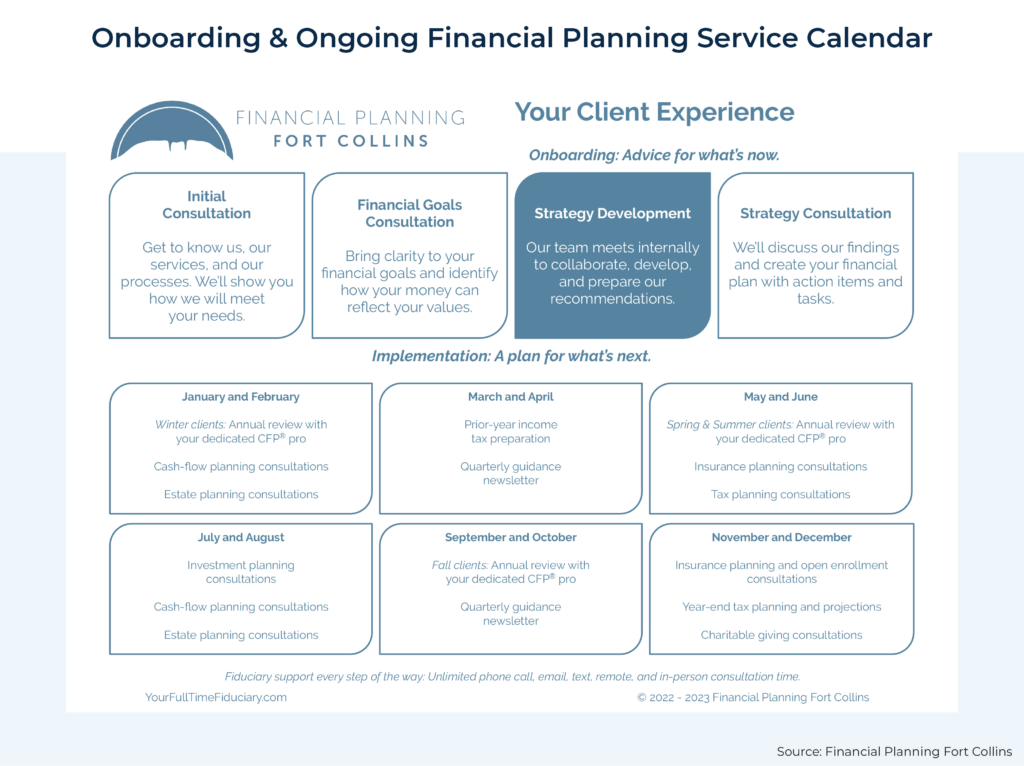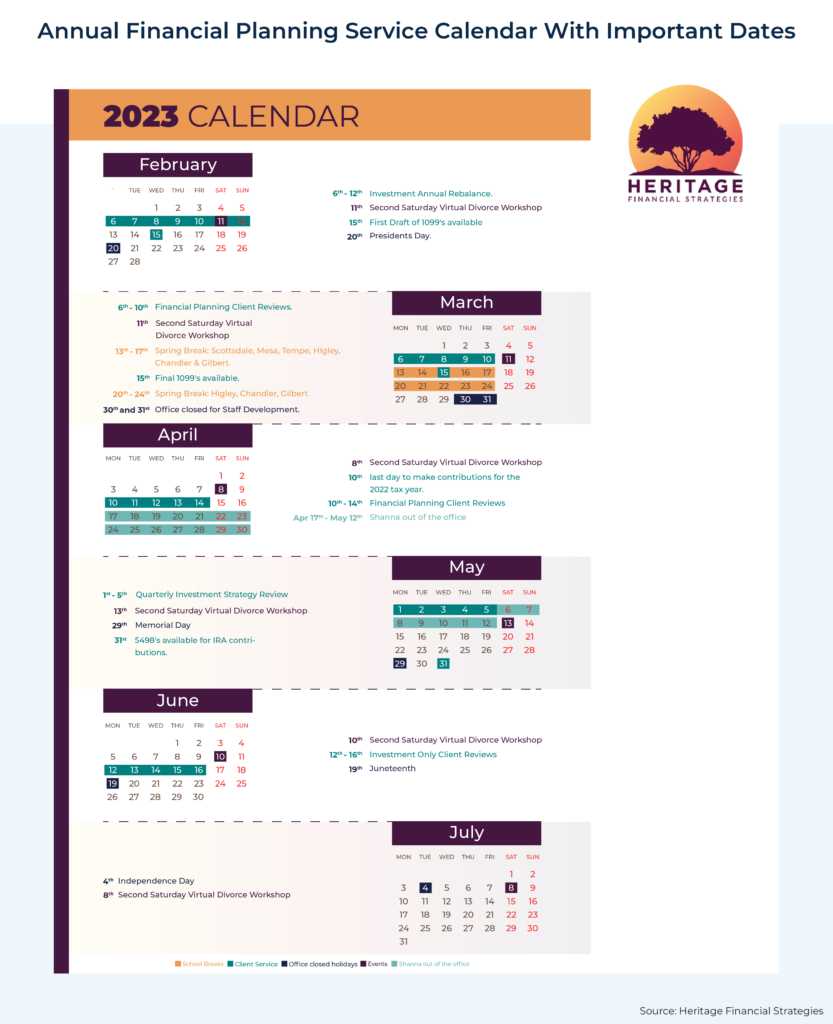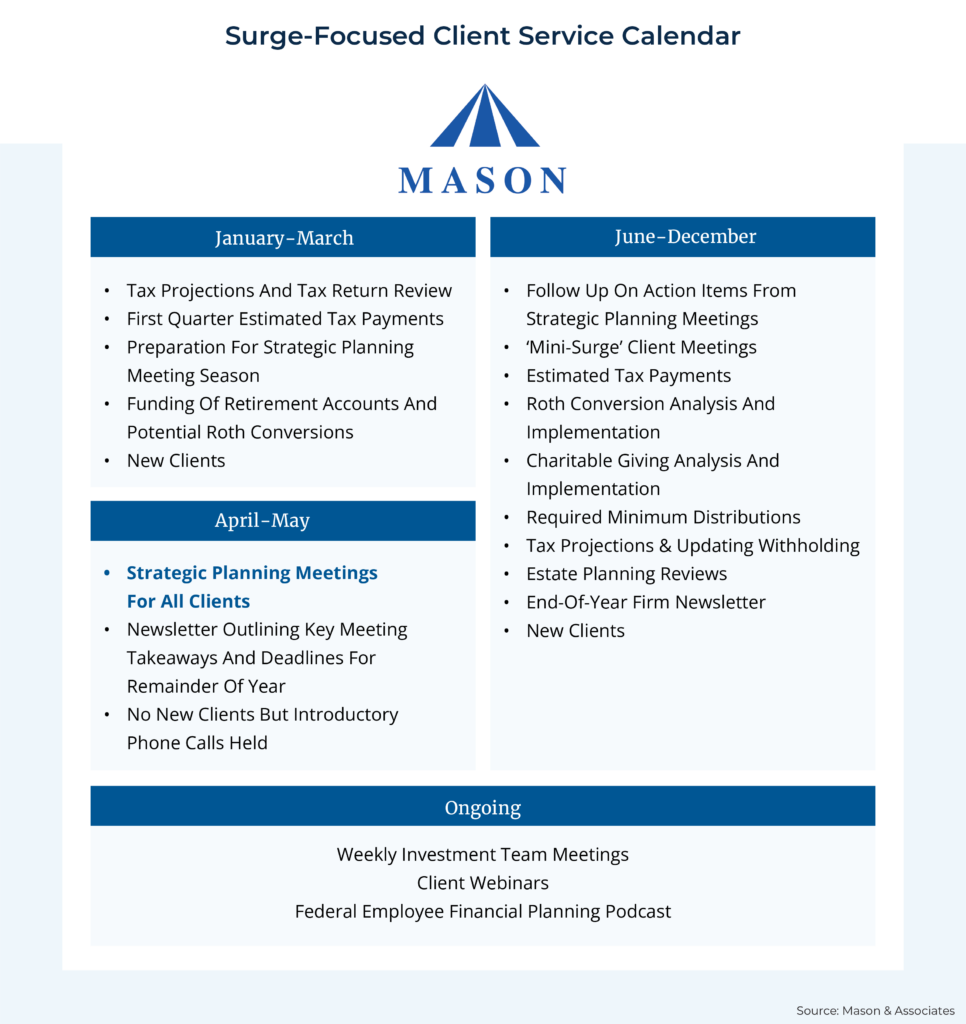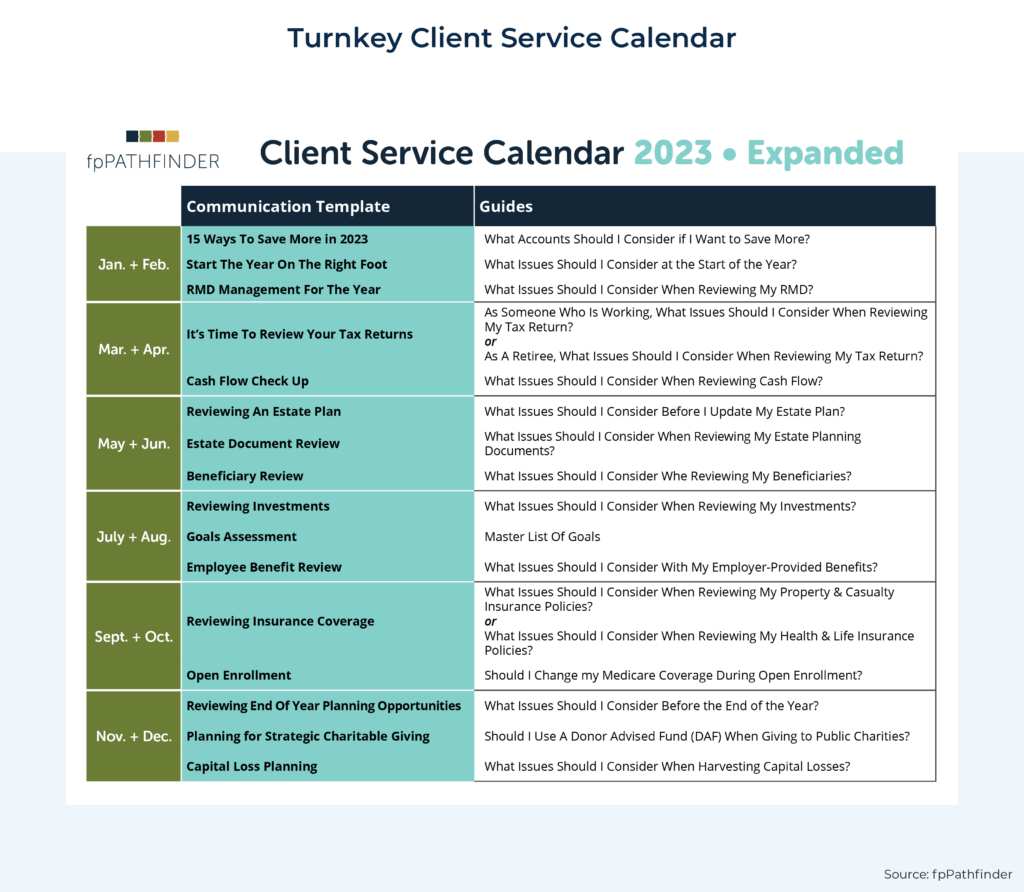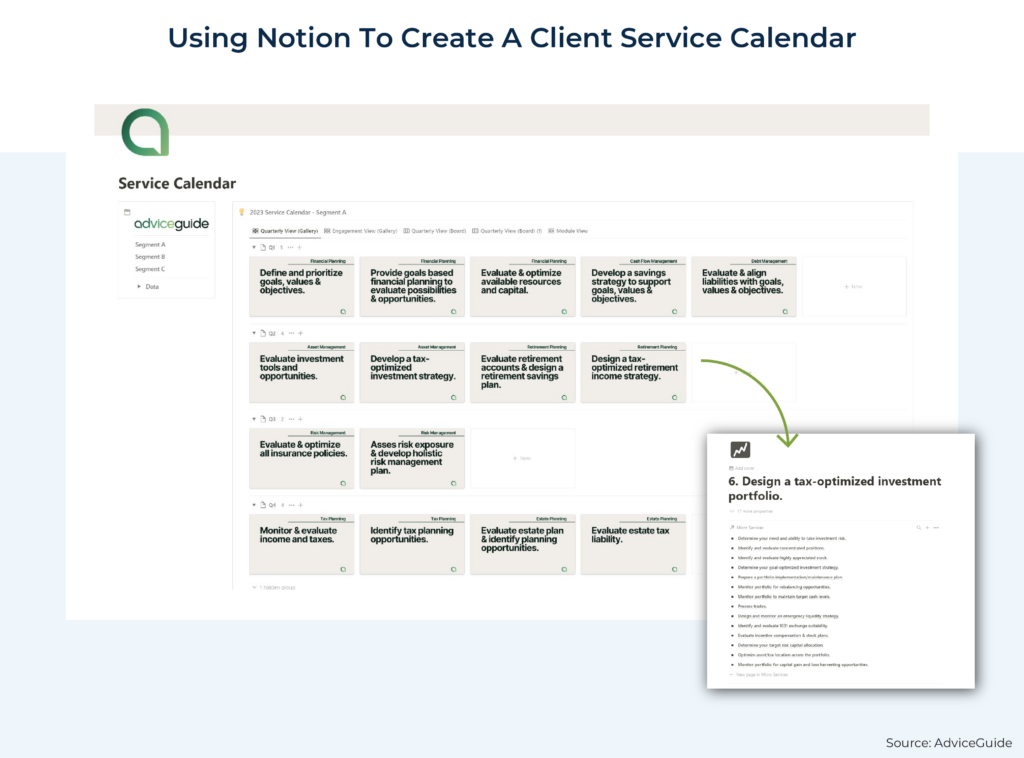Executive Summary
While it can be easy for financial advisors to recognize the wide range of ways they add value for clients throughout the year, clients themselves might not be aware of what their advisors do for them behind the scenes outside of their annual meetings (e.g., rebalancing their investment accounts or reviewing their insurance policies). Without knowledge of this ‘shadow work’, clients might not recognize the full breadth of responsibilities their advisor (and the firm’s back-office staff) are handling on their behalf to justify their fee.
One of the ways advisory firms can help solve this dilemma is to implement a client service calendar, which outlines key services being provided to clients during each month of the year. This not only gives clients a better idea of the actual work involved in financial planning that goes on outside of meetings but also helps them understand when the work happens during the year. Additionally, client service calendars can help manage client expectations while allowing advisors to adhere to their preferred service cadence (recognizing that some client issues will likely need to be handled on an ad hoc basis). Furthermore, by outlining the actual scope of work the advisor performs for clients, client service calendars can be helpful when it comes to dealing with regulators, who may need to assess the specific services provided by advisors to ensure that these services justify client fees.
When creating a client service calendar, advisory firms have many styles to choose from to meet their specific needs. For example, firms can opt for a monthly, bi-monthly, or even daily calendar, depending on what they want to display for their clients. And client service calendars can be implemented in a variety of ways, from a single-page calendar that serves as a useful handout during prospect and client meetings to a daily calendar with important dates that clients actually want to hang on their refrigerators and reminds them of the value their advisor is providing!
Once an advisory firm identifies what they want its service calendar to do (e.g., demonstrate ongoing value and serve as a client engagement tool) and chooses an appropriate style that supports its calendar’s function, it can then consider how to actually create its client service calendar by deciding what to include in the calendar and which tools they want to use to produce the calendar. These decisions will depend on several factors, from the type of calendar and the amount of detail included, to whether the calendar is meant to be used as an in-meeting resource or to be kept by the client for their regular reference. And with a variety of technology tools and outsourced solutions available to help them create and implement their client service calendar, advisory firms can easily select the option that best meets their needs.
Ultimately, the key point is that client service calendars not only can allow firms to better organize and display their service offerings but can also show clients (and regulators) the full range of services being provided throughout the year. And by clarifying when planning services will be offered and when events relevant to clients will take place, advisory firm owners make the financial planning experience more tangible and create structure in their processes, all while giving advisors time to go deeper in serving their clients!
It is easy for financial advisors to recognize the wide range of ways they add value for clients throughout the year. A quick look at a client’s CRM file will show many of the tasks the advisor performed on the client’s behalf, some of which the client was aware of (e.g., an annual meeting), but also other items that the client might not have noticed (e.g., rebalancing their investment accounts). Without knowledge of this ‘shadow work’, clients might not recognize the full breadth of responsibilities their advisor (and the firm’s back-office staff) are handling on their behalf, which may help justify the advisor’s fee!
One of the ways advisory firms can help solve this dilemma is to implement a client service calendar, which outlines key services being provided to clients during the year. This not only gives clients a better idea of the actual work involved in financial planning that goes beyond meetings, but also helps them understand when the work happens during the year. In addition, advisory firms can customize the calendar based on when they prefer to offer their specific services, potentially improving efficiency by focusing on certain tasks systematically at certain times rather than on an irregular basis. And with the availability of a wide variety of styles and tools to design client service calendars, advisory firms can create a calendar that matches their preferred service cadence and their clients’ specific needs!
Why Client Service Calendars Can Be Valuable
By listing the primary services that will be provided during each month of the year, advisors can give clients a better understanding of the value they receive from the firm. Importantly, advisory firms do not have to include everything they do for their clients, as such a calendar could grow overly cumbersome and hard to interpret. Instead, the most effective client service calendars illustrate the key work and deliverables being prepared for the client.
Further, clients are not the only parties interested in the services an advisory firm provides throughout the year. Charged with protecting the public from unscrupulous advisors, regulators work to ensure that the advisor provides clients with services that justify their fee. Which means that client service calendars not only help advisors to attract and retain clients by clearly illustrating their value, but they can also help to keep them in good standing with their regulator(s) by outlining the actual scope of work the advisor performs for clients.
Client Service Calendars Make The Financial Planning Experience More Transparent
When a prospect meets with a financial advisor, they might not know what to expect from the relationship: They might think the extent of what they will receive includes an initial financial plan and ongoing investment management, and they might not be aware of the full list of services the firm offers their clients. Further, this lack of awareness can apply to current and long-time clients as well; because they are likely to have fewer touchpoints with the advisor after the intense initial onboarding period, they might not have the full picture of what the advisor does for them during the year.
By using a tangible client service calendar that a client can see and touch (at least virtually), an advisor can display the work they are performing throughout the year to demonstrate the ongoing value they provide to clients. For instance, in January, an advisory firm might produce annual performance reports for every client (a tangible item that clients will see) and also conduct an internal portfolio review and rebalancing (a service that could be completed without the clients noticing – unless they are paying close attention to their monthly statements) as well as hold a semi-annual client appreciation event (to give clients something to look forward to during the year!). The firm can then fill in the remaining months of the year with other services they provide, based on either the firm’s preferred cadence or deadlines that are consistent each year.
For example, a firm primarily working with young families might include in its service calendar an update of retirement and college projections for all of its clients in the early Fall (when education is often at the top of their minds), while a firm working with retirees could complete a Medicare coverage analysis for its clients in advance of the annual Open Enrollment Period.
In addition, a client service calendar can let clients know when to expect certain tasks to be completed. For instance, if a client knows that their advisor will review their tax return for potential planning opportunities each year in May, they will probably be less likely to send an urgent email to their advisor in March to review their recently filed return (and more likely to know that they’ll need to share their tax return with their advisor in advance!). This not only saves the advisor time (and can also prevent the rise of potential dilemmas of whether to immediately serve the client’s request when the advisor might have other priorities), but it also gives clients the confidence that their return will be reviewed each year.
Client Service Calendars Can Help Regulators Identify Work Being Performed By Financial Advisors Throughout The Year
Historically, portfolio management has been at the center of the advisor value proposition, and advisory fee structures have reflected this emphasis, with charging on an Assets Under Management (AUM) basis being one of the more popular options. Though notably, the time an advisor takes managing a client’s portfolio can vary greatly, as some advisors conduct regular portfolio reviews and actively make trades to rebalance the portfolio's allocation, while others might select a few broad-based index funds for a particular client and leave the portfolio alone throughout the year (or even longer).
Regulators have long been aware of ‘reverse churning’, where the advisor receives an ongoing advisory fee but doesn’t actually do anything to earn their fee. With this in mind, advisors who may not focus their work on a more active portfolio management process can use a client service calendar to show them the other financial planning services being provided throughout the year to justify their fees.
And this benefit is not limited to advisors charging on an AUM basis; in fact, it might be even more valuable to firms who charge clients monthly on a fee-for-service basis (e.g., retainer models), as regulators might want to identify the services a client is receiving for each monthly billing charge. By having a service calendar available showing the work performed each month (perhaps combined with CRM records showing that given tasks were completed for each client), advisors can potentially better satisfy regulators that the work they perform justifies the fee they are charging.
Client Service Calendars Allow Firms To Construct A Schedule Based On Their Needs
For many entrepreneurially minded advisors, one of the attractions of starting their own firm is being able to control their schedule. But as a firm grows, some advisors find that they are running short on time, jumping from task to task and meeting to meeting. In addition, some advisors have preferences for how much they work during different times of the year; for example, an advisor with school-age children might want to work fewer hours in the summer to spend more time with their kids when they are out of school. And so, by helping advisors formalize a schedule that is shared with clients, a client service calendar can function to manage client expectations (while recognizing that some client issues will need to be handled on an ad hoc basis), allowing an advisor to customize their service cadence to fit their preferred annual schedule.
While client service calendars can be effective for firms with a variety of client meeting cadences, they can be particularly valuable for firms that bunch client meetings into certain months of the year. For instance, an advisor using the client surge meeting approach might hold multiple client meetings per day for 3 days a week over a 1-month period, which allows them to separate the ‘factory work’ of planning (e.g., updating client information and completing paperwork) from the ‘focus work’ (e.g., detailed planning analyses).
A client service calendar fits well with this approach, as the advisory firm can choose the months when it wants to hold surge meetings and fill in the rest of the calendar with the other services they complete (or time they take off from work) throughout the year as they might have little time for other tasks during surge months).
The key point is that service calendars are valuable not only for showing clients (and regulators) the financial planning services being performed throughout the year but also for providing advisors the flexibility to decide when they want to complete certain tasks based on their preferences. And after determining which services to list on the calendar and deciding when they will be completed, advisors can choose from the range of calendar options to best fit their firm’s (and their clients’) needs.
How Firms Can Select The Best Client Service Calendar Style To Fit Their Needs
When creating a client service calendar, advisory firms have many styles to choose from to meet their specific needs. For example, firms can choose a monthly, bi-monthly, or even daily calendar, depending on what they want to display for their clients. And firms have successfully implemented client service calendars in a variety of ways, from a single-page calendar that serves as a useful handout during prospect and client meetings to a daily calendar that clients actually want to hang on their refrigerators and reminds them of the value their advisor is providing!
Creating A Client Service Calendar To Demonstrate Ongoing Value To Prospects And Clients
At their core, client service calendars allow advisors to demonstrate the value they are providing clients throughout the year. As previously discussed, this is important both for prospects (who might not know what to expect both during the onboarding process and when they become ongoing clients) as well as current clients who might have limited touchpoints with their advisor.
For example, Colorado-based RIA Financial Planning Fort Collins created a client service calendar that shows both its onboarding and ongoing planning cadences. While prospects can see the firm’s 4-step onboarding process, the calendar also helps them understand what to expect once their plan is implemented after they become ongoing clients. At the same time, existing clients can refer to the calendar to easily remember how the firm’s ongoing key services are divided into 6 distinct 2-month blocks and when annual review meetings (which take place seasonally during 6 months of the year), consultations on key planning topics (e.g., tax planning, insurance planning, and estate planning), quarterly tax guidance newsletters, and subject-matter expert webinars will take place.
This calendar design reflects the firm’s ensemble approach, where clients engage with multiple advisors during the year who specialize in specific planning areas. It has also reduced the need for ‘pinballing’ between client questions on disparate topics (which can be much less efficient than focusing on one planning area at a time, as researching a large number of disorganized topics all at once can take a large amount of time and mental energy), as the clients can see on the calendar when their primary planning areas will be reviewed next.
An additional benefit of Fort Collins’ client service calendar is that it allows the firm to carve out certain months to dig deep into certain planning topics; for instance, in March and April, the firm focuses on tax preparation and sends a quarterly guidance newsletter. This schedule is not only relevant for clients (who will understand that their tax returns will be prepared during these months) but also useful for advisors, allowing them to focus on tax planning for clients without being interrupted by client meetings.
Altogether, Financial Planning Fort Collins has created a calendar that not only promotes client acquisition and retention but also allows them to provide a deeper level of service!
Creating A Client Service Calendar That Clients Will Want To Display
While client service calendars are often introduced and reviewed during prospect and client meetings, they can also serve as a take-home item for clients to reference during the year. Arizona-based firm Heritage Financial Strategies makes its client service calendar more valuable to its clients not only by including key client services on its calendar but also by adding important dates (including some that are not related to the financial planning process), making it even more useful as a general calendar for clients.
The calendar highlights various financial planning services, including the dates of financial planning client reviews and the firm's monthly virtual divorce workshops. Each day of the year is displayed on the calendar, allowing the firm to set expectations by noting when the office is closed and when its lead advisor is out of the office. And because almost all of the firm’s clients are local, the calendar includes the holidays for local school districts, serving as a useful reference tool for clients with school-aged children.
In sum, by creating a calendar that many of their clients want to keep as a handy reference on their refrigerator, Heritage Financial Strategies is able to help set client expectations and remind clients about the value it is providing during the year!
Creating A Client Service Calendar For A Focused Surge Structure
As discussed above, many firms have adopted client meeting surges to condense the time spent holding annual meetings with clients into certain months, freeing up significant time during the rest of the year for deeper financial planning analysis, business development, follow-up tasks, and other responsibilities. While some firms schedule surge meeting periods on a bi-monthly or quarterly basis, others condense all of their annual meetings into a single period. This is the case for Mason & Associates, a Virginia-based RIA that specializes in serving current and retired Federal employees.
Mason & Associates schedule annual “strategic planning meetings” with clients during their surge window in April and May, holding 17 meetings per week during this period. This allows the firm to have a single client service calendar that is applicable to all clients, as all clients have their strategic planning meetings during the same period and annual meetings are not spread throughout the course of the year.
From January through March, the firm conducts tax planning analyses, onboards new clients, and, starting in mid-March, prepares for its strategic planning meeting season. Then, during the remaining months of the year, from June to December, the firm has time to follow up on action items from its strategic planning meetings, handle time-sensitive planning tasks (e.g., ensuring RMDs are taken), and bring on new clients.
The firm also holds ‘mini-surge’ meetings from Tuesday through Thursday during the first and last weeks of the month (other than April and May) to give clients time to meet with their advisor while leaving significant time blocks open for the firm to complete its other planning responsibilities.
While the 2-month strategic planning meeting season in April and May is intense, it allows the firm to spread out its other planning responsibilities throughout the year, creating sufficient time for deeper planning assessments and business development while still setting aside set time for clients who want to meet during the rest of the year!
How Firms Can Create Their Own Client Service Calendars
Once an advisory firm identifies what they want its service calendar to do (e.g., demonstrate ongoing value, serve as a client engagement tool) and chooses an appropriate style that supports its calendar’s function, it can then consider how to actually create its client service calendar by deciding what to include in the calendar and the tools they want to use to produce the calendar.
These decisions will depend on several factors, from the type of calendar and the amount of detail included, to whether the calendar is meant to be used as an in-meeting resource or to be kept by the client for their regular reference. And with a variety of technology tools and outsourcing solutions available to help them create their client service calendar, advisory firms can select the option that best meets their needs.
Choosing Services To Include On The Client Service Calendar
Once an advisor has selected a style for their client service calendar, they can then consider the services they want it to include. Of course, given that firms do a wide range of tasks on behalf of their clients throughout the year, not everything needs to be included.
In addition, advisors can consider whether they want to create a single client service calendar (which might be optimal for firms with similar clients or firms using a surge meeting approach) or multiple calendars (e.g., a firm could create separate service calendars for its working-age clients and those who are retired so they can drill deeper into the services offered to each group), though the latter could increase the time burden on the advisor (not only in creating the calendars but also in providing the differentiated services on them!).
Some firms might find that their current service offerings fit neatly into a 12-month calendar, while others might feel that certain months could use additional client services. To help build out their calendar, this latter group can take advantage of a turnkey option to build out their client service calendar by creating relevant touchpoints with their clients.
For example, fpPathfinder offers an Expanded Service Calendar that advisors can customize to their needs. Their Expanded Service Calendar also includes email templates and guides covering a range of financial planning topics (e.g., reviewing insurance coverage) that advisors can implement in chosen months throughout the year.
Tools Advisors Can Use To Create A Client Service Calendar
Because most financial advisors are not graphic designers, they may wish to select from a variety of software tools to support the production of their client service calendar. For instance, software tools such as Notion and AirTable allow advisors to create, organize, and collaborate on client service calendars. Notably, the flexibility of these tools can be good options for firms with a diverse client base (who might require different types of services throughout the year) or those that want to include more detail describing each service offering than could reasonably fit on a piece of paper.
For example, consulting firm AdviceGuide used Notion to produce a sample service calendar that shows services the firm provides at a high level. Notably, an advisor can click on each ‘card’ to pull up the detailed list of tasks that the advisor will complete under each topic (e.g., evaluate estate tax liability), showing the client the full breadth of the services the advisor provides.
Advisors who want to design their own 1-page calendar can consider basic tools such as Google Slides (used to design the Financial Planning Fort Collins calendar displayed earlier) or Microsoft PowerPoint to organize and create a client-facing calendar.
Alternatively, advisors who know what they want to include on their client service calendar but want to outsource its design also have a considerable number of options to choose from. For example, Kimp offers unlimited graphic design for a flat monthly fee and could be useful for advisors who have other design needs in addition to their client service calendar, while firms that are more budget-conscious or who only need the occasional design project could choose freelancing services such as Fiverr.
Altogether, advisors have several options for producing their client service calendar, whether they decide to create a flexible online calendar or a hard copy print for clients to keep and reference regularly!
Ultimately, the key point is that client service calendars not only allow firms to better organize and display their service offerings but also let clients (and regulators) see the range of services being provided throughout the year. And by clarifying when planning services will be offered and when events relevant to clients will take place, advisory firm owners can not only make the financial planning experience more tangible, but they also structure their services to meet the unique needs of the firm and their clients. All while giving advisors time to go deeper for their clients!


